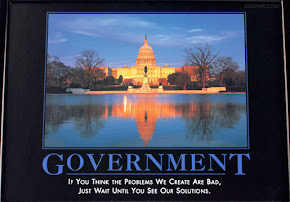Friday, February 24, 2012
High Gas Prices: Obama's Half-Truths vs. Reality
When Stephen Chu, Obama's Energy Secretary says "Somehow we have to figure out how to boost the price of gasoline to the levels of Europe", it is a little hypocritical for the President to say he is doing everything that he can to reduce the price. Obama believes it is necessary to increase the cost of energy to an unsustainable level in order for him to pass his Cap and Tax policies for total governmental control of carbon emissions. Despite overwhelming evidence that there has been no global warming for the last ten years, Obama persists in his support of the fringe wacho environmentalists who believe that there are too many people on this earth and we are destroying it.
Excerpt: The national average for gas prices is almost $3.60 per gallon, increasing 40 cents from a year ago and jumping 20 cents from just one month ago.[1] Prices are already surpassing $4 per gallon in some states and could threaten the country’s economic recovery.
Higher gas prices drive up production costs for goods reliant on transportation, and more money spent at the pump means less money spent at restaurants and movie theaters. Buying fewer goods and services tightens the economic vice and holds back job creation.
Almost 70 percent of the price of gasoline comes from the price of crude oil, with excise taxes, refining costs, and retail/distribution making up the other 30 percent.[2] Exporting refined petroleum products comprises a small percentage of total domestic gas production and marginally impacts prices. Despite demand for oil falling in the United States as a result of a weaker economy and a warm winter curbing the use of heating oil, the industrial rise growth of China and India continue to put upward pressure on the price of oil. The threat of Iran restricting oil exports to Europe is also driving up the global price, impacting gas prices in the U.S.
Here are five half-truths that one continually hears about gas prices and five actions that Congress and the Administration can take to effectively combat high gas prices.
Half-truth #1: Oil production is the highest it has been in eight years.
Half-truth #2: Increasing oil production takes too long and would not impact the market for at least a decade.
Half-truth #3: Oil is not enough. America has only 2 percent of the world’s oil reserves.
Half-truth #4: Oil is not enough. The country needs an “all-of-the-above” approach to reduce its dependence on oil.
Half-truth #5: Speculators are driving up the price of gas, and they need to be reined in.
Five Actions for Congress and the Administration
Congress and the Administration should:
1. Get moving on permits.
2. Require lease sales when ready.
3. Create a sensible review processes.
4. Remove regulatory delays and limit litigation.
5. Approve the Keystone XL Pipeline.
Let the Market Work
The market would respond if Congress and the Obama Administration allow it to work. Oil companies would respond by increasing their production, and consumers would switch to more fuel-efficient cars without any need to mandate more fuel-efficient trucks and cars. If the price of gasoline continues to rise, it will make alternative technologies all the more economically competitive.
Read full Heritage Foundation report that discusses each of the proposals above, here.
Excerpt: The national average for gas prices is almost $3.60 per gallon, increasing 40 cents from a year ago and jumping 20 cents from just one month ago.[1] Prices are already surpassing $4 per gallon in some states and could threaten the country’s economic recovery.
Higher gas prices drive up production costs for goods reliant on transportation, and more money spent at the pump means less money spent at restaurants and movie theaters. Buying fewer goods and services tightens the economic vice and holds back job creation.
Almost 70 percent of the price of gasoline comes from the price of crude oil, with excise taxes, refining costs, and retail/distribution making up the other 30 percent.[2] Exporting refined petroleum products comprises a small percentage of total domestic gas production and marginally impacts prices. Despite demand for oil falling in the United States as a result of a weaker economy and a warm winter curbing the use of heating oil, the industrial rise growth of China and India continue to put upward pressure on the price of oil. The threat of Iran restricting oil exports to Europe is also driving up the global price, impacting gas prices in the U.S.
Here are five half-truths that one continually hears about gas prices and five actions that Congress and the Administration can take to effectively combat high gas prices.
Half-truth #1: Oil production is the highest it has been in eight years.
Half-truth #2: Increasing oil production takes too long and would not impact the market for at least a decade.
Half-truth #3: Oil is not enough. America has only 2 percent of the world’s oil reserves.
Half-truth #4: Oil is not enough. The country needs an “all-of-the-above” approach to reduce its dependence on oil.
Half-truth #5: Speculators are driving up the price of gas, and they need to be reined in.
Five Actions for Congress and the Administration
Congress and the Administration should:
1. Get moving on permits.
2. Require lease sales when ready.
3. Create a sensible review processes.
4. Remove regulatory delays and limit litigation.
5. Approve the Keystone XL Pipeline.
Let the Market Work
The market would respond if Congress and the Obama Administration allow it to work. Oil companies would respond by increasing their production, and consumers would switch to more fuel-efficient cars without any need to mandate more fuel-efficient trucks and cars. If the price of gasoline continues to rise, it will make alternative technologies all the more economically competitive.
Read full Heritage Foundation report that discusses each of the proposals above, here.
Labels:
Big Government,
Cap and Tax,
Gasoline,
Obama,
Oil and Gas
Subscribe to:
Post Comments (Atom)






























No comments:
Post a Comment